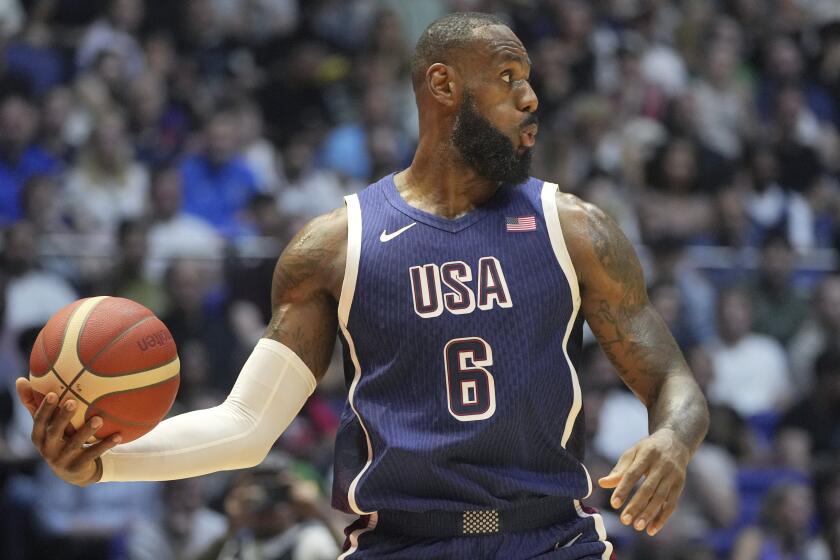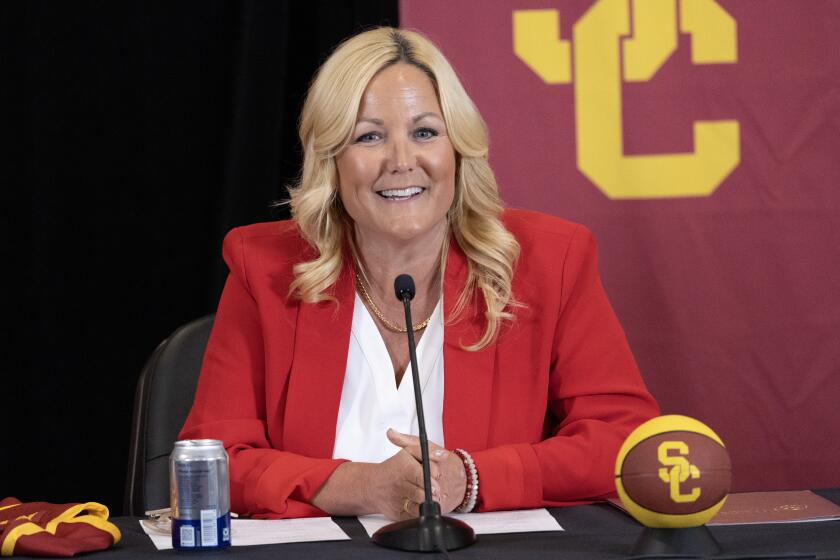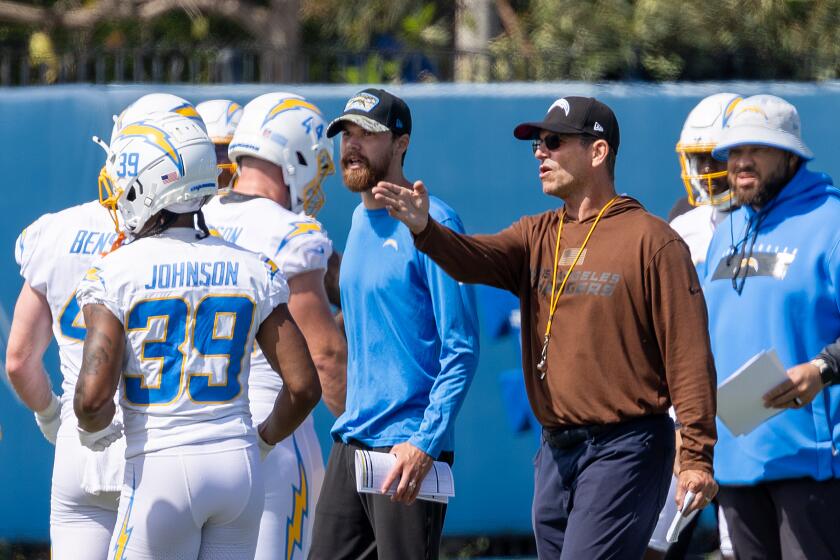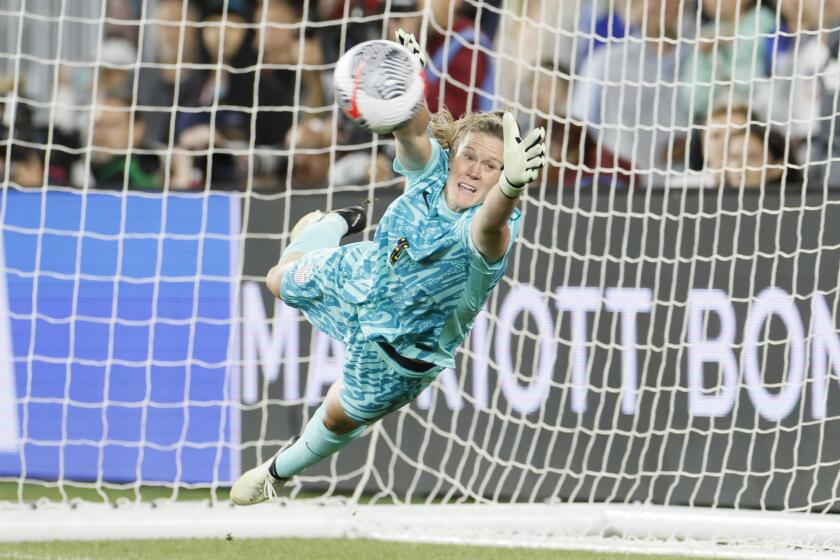In Baseball vs. Rose, Gray Is Not a Player
Regarding Sunday night’s now-famous Jim Gray interview of unrepentant, still-defiant, banned-from-baseball-because-of-betting Pete Rose:
Is the man incapable of admitting guilt?
We’re a compassionate nation. All he has to do is say he regrets what he did, and we forgive him. All we want is an apology from this man who has been an embarrassment to his profession. All we want is a little humility.
But no.
Jim Gray refuses to say he’s sorry.
Who appointed NBC reporter Gray spokesman for the U.S., or even baseballdom? It wasn’t his aggressive questions to Rose that were out of whack after the televised gala for baseball’s All Century Team prior to Game 2 of the World Series. TV’s sports-reporting corps already has too many softies who see themselves as extensions of the industry they cover.
No, it was the way he insinuated himself into the story by deploying the “people-think-you-should” tone in repeatedly challenging Rose to publicly apologize for gambling while in baseball.
The “people” in this case meant Gray himself, just as the editorial “we” that I used at the beginning of this column is actually me.
What Gray did--not for the first time, by the way--was an extension of an ‘80s and ‘90s metamorphosis in TV journalism that finds the reporter not only eclipsing but becoming the message. It’s a deepening problem that needs to be addressed by this medium whose messengers increasingly screw themselves into stories like thousand-watt celebrities.
Gray questioning Rose about his difficulties is fine. Gray vs. Rose isn’t.
A little compassion is in order here, for like runaway gambling, this self-important, too-big-for-his-britches reporter thing is a sickness, a treatable addiction. All we the people (I, myself and me) want from Gray is an apology and promise that he won’t do it again.
The Gray episode provides more hot rhetoric for hair-triggers to fire at the media. You can almost see them quick-drawing and slapping leather right now.
News types aren’t the only target, of course. The assault is much wider.
The clean-up-the-media fusillade comes also from the cause-and-effect crowd whose hysterical mantra about TV, movies and video games creating an ever-longer assembly line of youthful killers--an image magnified by the shootings at Columbine High School in Littleton, Colo.--appears to make perfect sense.
Until reality intervenes.
Firing up a caldron of fear, these anti-media crusaders create an impression that Americans are meaner than ever and that crime in the U.S. is on the dramatic upswing. Nope.
The latest FBI figures show juvenile arrests for serious and violent crimes falling nearly 11% from 1997 to 1998, more than double that for adults. That’s so, the feds say, even though the teen population continues to grow.
This is hardly a freaky glitch, for juvenile crime has been sloping downward since 1993, the FBI says. And serious crimes for all ages fell in 1998 for the seventh consecutive year, it says, the longest continuous decline since the FBI began collecting crime data in 1930.
If we blame the media when crime is up, shouldn’t we credit them when crime is down? Or instead, should we scrap all of that and pursue another course when examining media?
Pick No. 2, and you earn a gold star.
“We don’t believe in this cause-effect business,” said Elizabeth Thoman, founder and president of that enormously valuable resource, the Center for Media Literacy in Los Angeles. “Imitation of behavior doesn’t begin to plumb the territory. It just gets us back to the blame issue. I don’t even want to go there.”
And she doesn’t.
Proof comes Saturday when the center rolls out a thick red carpet of workshops for teachers at St. Anne’s Conference Center in Los Angeles. The highly worthy occasion is its first Media Literacy Day--Bravo!--which Thoman hopes to expand to several times a year.
It aims to give teachers the information and tools to help students and their families “analyze today’s media culture and build the skills, attitudes and behaviors that promote healthy lifestyle choices and positive, productive values for the home and workplace.”
You know, what Jerry Springer doesn’t teach them.
Just a few of the workshop titles:
* “Babes & Studs: The Politics of Appearance.”
* “Whose Stories Are Told? Identity in a Media Age.”
* “Teen Sexuality in a Culture of Confusion.”
* “God on the Silver Screen: Issues of Faith in a Media Culture.”
* “Hollywood Does History: Separating Fact From Fiction at the Movies.”
* “Confession of a Prime Time Killer: Rethinking Media Violence and Boys.”
The latter is taught by James Read, who played a variety of bad guys in 20 years of film and TV acting, and is now a psychologist who lectures widely on media literacy. He and nine others teaching Saturday’s 20 workshops are graduates of the center’s Felton Media Literacy Scholars Program, funded by pioneering TV producer Norman Felton (“Dr. Kildare,” “The Man From U.N.C.L.E.”).
Thoman and her group are hardly the only ones in the media-literacy business. On Tuesday night, for example, entertainment-industry types here were to meet and exchange ideas with Elana Rosen, who runs the younger, well-respected Just Think Foundation in San Francisco, which has developed its own media education curriculum.
I don’t pretend to be unbiased on this topic. In fact, I’m a super fan.
Jim Gray interviewing Pete Rose speaks shrilly for itself. Nothing much to see through. But what of the twistier labyrinths of mass media and popular culture? Media literacy--teaching teachers to lead kids and others safely through this maze--is flat out the sanest, surest route to the Holy Grail of reform. And a smart alternative to marching on Hollywood and other entertainment and media centers.
Impart critical thinking to children when they are very young--give them smarts that lift their expectations--and perhaps some day they’ll part the Red Sea and lead us from the wilderness.
We the people command it.
More to Read
Go beyond the scoreboard
Get the latest on L.A.'s teams in the daily Sports Report newsletter.
You may occasionally receive promotional content from the Los Angeles Times.






